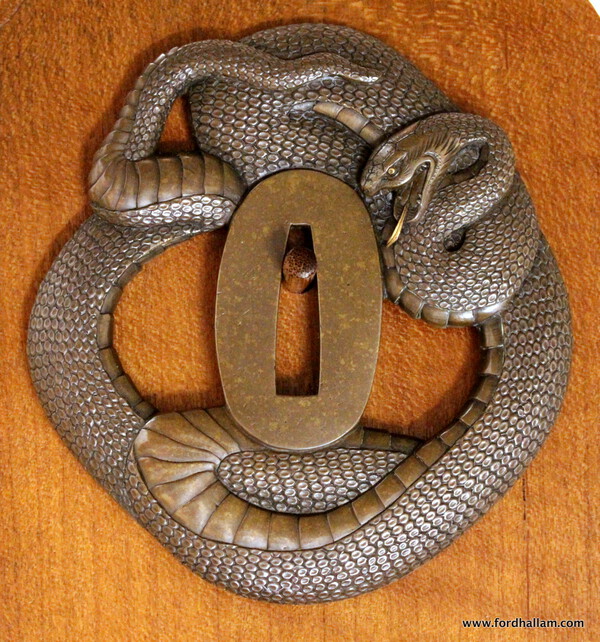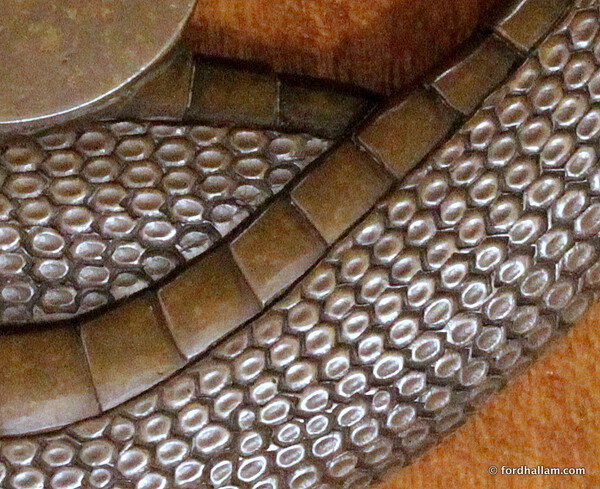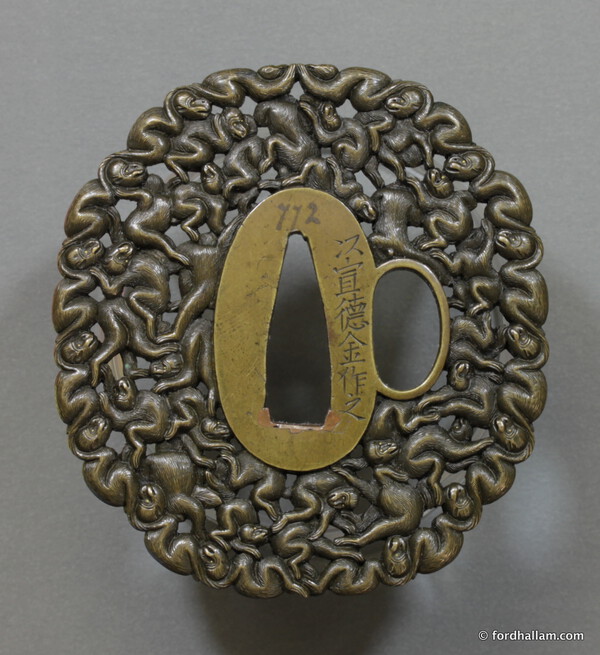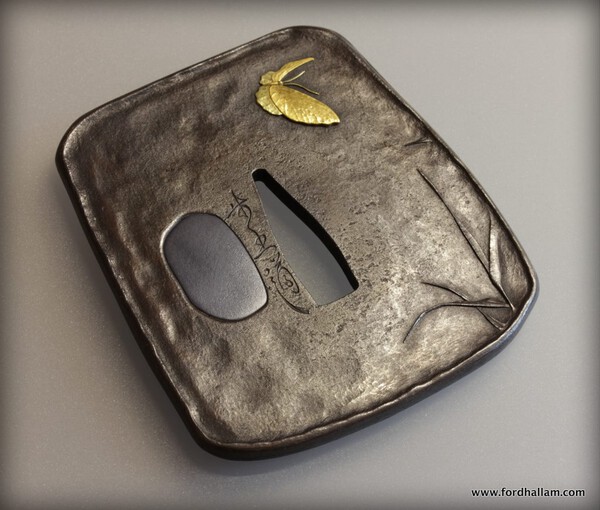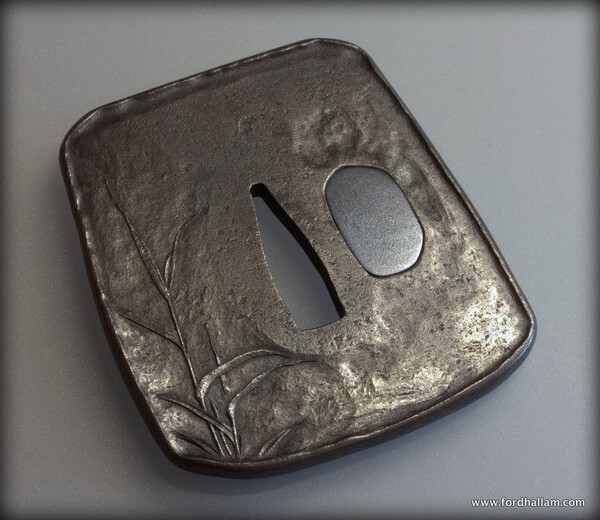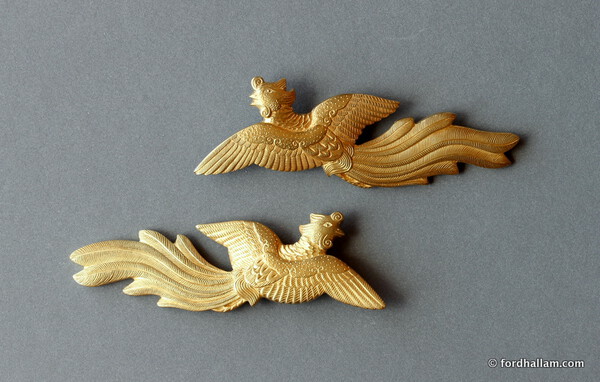-
Posts
3,091 -
Joined
-
Days Won
78
Content Type
Profiles
Forums
Events
Store
Downloads
Gallery
Everything posted by Ford Hallam
-
Steve, mea culpa, my comments were focussed exclusively on Japan.
-
Rivkin As I explained before; "Metallic copper, that could simply be melted as found, was never discovered in Japan. This is one of the reasons Japanese metalworking culture started so much later than Korea's. When metalworking technology was introduced to Japan in the 6th century from Korea it was sufficiently advanced as to allow the reducing and smelting of copper ores." All copper produced in Japan came from copper ores. The formation of the earth and the science of geology explain why this is so. No copper was imported post 7th century, we don't actually know if any ever was. Iron imports are attested to but not copper. Certainly the more than 400 tonnes used to cast the Great Buddha in Nara in 752 came solely from Japanese mines, predominantly Naganobori. Rather, Japan was a major global exporter of copper. In fact the largest exporter of copper in the world in the 17th century. Japanese copper is often argetiferous, yes, but the amount of copper extracted in the refining of the silver was generally quite minimal, certainly not a significant addition to the overall copper production. Sado was predominantly a gold mine, probably the most famous/productive gold mine in Japan. If we're talking about copper the big mine that starts it all would be Naganobori, producing the greatest amount of Japan's copper since at least the 7th century. I don't know where you get the idea copper and gold were mined/extracted together....they don't occur together in nature. As for the rest of what you've thrown into your post... If you want to cite random alloys you're actually undermining your own original idea. To make alloys you need to start with reasonably well defined ingredients...or it's all just a matter of random mixtures and not really controlled alloying. Coinage, by definition, must be fairly well defined in terms of composition, so your examples are irrelevant. But out of interest, what else was in that Nagasaki coin?
-
Edo period copper was in fact the purest in the world prior to the late 19th century. Typical analyses of copper from the start of the Edo period reveal a remarkably pure metal with only traces of lead, generally under 0.5%. This is a residue from the various refining processes used from the mid 16th century, the so called 'namban buki' or cuppelation process. Metallic copper, that could simply be melted as found, was never discovered in Japan. This is one of the reasons Japanese metalworking culture started so much later than Korea's. When metalworking technology was introduced to Japan in the 6th century from Korea it was sufficiently advanced as to allow the reducing and smelting of copper ores. The tsuba in question may be copper, although a variety of bronze and brass type alloys were in use in the late Edo period. If it is copper my bet would be that it's pretty pure and contains as little as 0.3% lead and not much else.
-
Hi Ken I reckon this is the work of an over-ambitious contemporary amateur. It's as rough as a goat's knee imo As for the rarity of MOP plugs, I can't recall having seen any before although I have seen it as inlay on a few pieces, there's an iron tsuba with MOP cherry blossom petals in the MET and of course Murakami Jochiku was noted for his use of MOP.
-
Sorry for my absence gents. I'm in the middle of a house move and am off the the US on the 1 April. But the tsuba will be taken care of, have no fear and prepare to be amazed
-
These are almost always cast brass pieces and frequently seem to have been originally silver plated. They do tend to be fairly well finished. The scales are not actually carved but in fact formed by the use of two punches. One creates the outer shape of the individual scale and another is used to stamp the dimple in the centre of the scale. Of the two examples Ian has posted above the one on the right reveals a very clear and bold crystalline structure that is indicative of 'as cast' brass. This means the metal has not been forged in any way as forging breaks down that large structure. They appear to me to be very late 19th century phenomena with many examples being almost identical, despite the variety of signatures they bear, this suggests to me a single place of manufacture. My personal feeling is these may have been made once foreign visitors were actively buying 'samurai treasures' because I don't think serious Edo period tsuba buyers would have accepted this obvious 'mass production' approach in terms of the processes employed. Here's another which exhibits that 'as cast' structure on the seppa-dai. The snake motif, in this bold style was, of course, used by a number of legitimate tsuba-ko in the Edo period but these late cast versions rarely appear to have been mounted and the nakago-ano are often very badly shaped, suggesting to me, again, that they were made for a clientèle unfamiliar with 'real' tsuba.
-
Guido is absolutely correct. Copper can be patinated to a black colour but it isn't the same as shakudo. Shakudo's unique patina is totally dependant on the alloy composition. And I agree, why destroy a perfectly pleasing copper patina. Some might call that cultural vandalism.
-
Stephen, that's exactly why I need more tsuba, duh! I reckon 2 or 3 should do it.
-
Hi Joe, sorry to disappoint but no such plans right now. I'm only trying to create a clear picture of the alloys origins and evolution.
-
No, I don't have a warehouse full of typewriters and fancy having a go at rewriting all of Shakespeare I'm looking for some more of these, specifically tsuba signed Mitsuhiro ( either or both generations) and baring an inscription identifying the metal as sentoku/sentokudo/kin as in this example. As some of you may know I've been immersed for some time now in researching the origins and compositions of traditional Japanese metals and alloys. One area I'm presently tidying up in my survey is that of brass/shinchu and brass/bronze type alloys, specifically sentoku. Sentoku was quite popular among bronze casters in the Meiji period but the only tsuba maker (no other tosogu I'm aware of) who can be pointed to as at least claiming to have used it would be Mitsuhiro, he of the 100 monkeys (and horses ) fame. I've got one fine example here and have had it analysed, non-destructively, and found the results intriguing... There's a possibility of some connection with the original 15th century Xuān dé bronzes that the Japanese version is said to be emulating. That's a separate area of investigation I've already explored. I'm doing a series of analyses at the V&A archive in London on the 14th March and will be examining their Mitsuhiro monkey tsuba. So I'm looking for some more examples to add to this mini-study to see what the data suggests. The testing is non destructive. If you're in the UK, or maybe even the EU, and have a suitable example you'd be willing to lend me for a couple of days I'd be grateful to hear from you. Thanks for your interest. Ford Hallam
-
Brian Ayres' reference to Ichigo's personal struggles actually bring to the fore yet another facet as yet unexamined by the conservative tosogu community. We're told that Ichijo is the last master of the Goto line and that somehow he revived the School's reputation. The actual social and economic realities would seem to contradict that story. On the other side of the conversation Katsuoshi was doing remarkably well. In fact of all the artists who where really born of the Edo period tosogu tradition Katsuyoshi was probably the most successful artist in terms of making the transition from tosogu to export objet d' art. The letters between Ichijo and Katsuyoshi reveal the profound differences in the way the older generation and the younger artists dealt with the changing times. Neither Kano Natsuo nor Hagia Katsuhira struggled to keep working or selling their wares. In fact there are a number of artists who kept alive to current trends and sold work directly to American collectors who then donated the work to the MFA in Boston. As did a handful of senior Mito artists who were able to recognise and express the desired aesthetic of the period. What I'm alluding to is the versatility of machibori as opposed to the rigidity inherent in the iebori. As Japan opened up to the modern world the Machibori artists were recruited by government sponsored companies to produce the amazing export ware that the Meiji period was famous for. Perhaps the political alignment of the Iebori schools with the old Shogunate also made then less approachable by the rapidly modernising merchant/common classes. But within 60 years no thread of either tradition was still alive.
-
Brain, we don't really have all that much period literature to form really detailed pictures of workshop practice...and I've been digging. I do think we may yet find useful material in time though. I think that given the many different schools and characters there may have been a variety of approaches. But we can be fairly sure that the work was handled by a number of different hands throughout it's creation. Just as in the famous painters studios in Europe from Mediaeval times at least. The notion, and importance, of the 'sole author' is a relatively new one in the history of applied art. I suspect even when the master was focussed on an important commission the studio would continue to keep making the 'bread and butter' work to keep the business going. Repair work would have been part of the business as was teaching classes for amateurs. Incidentally, that's a new area of research for me but it's looking quite interesting and might alter how we view unsigned pieces in future. Many of the big names were on retainers though, so earning weekly wages was not quite the rat race it is for us today. In fact there was some competition among wealthy daimyo and merchants to secure the services of the most popular artists so we can easily imagine how lucrative arrangements were made that did allow artists to really achieve ever more impressive results. And that, of course, was the whole point of commissioning new work, to impress.
-
Stephen it's in the Museum of Fine Art, Boston (MFA) you'll find it in their on-line collection, over 3000 pieces of tosogu available for study and with excellent enlargements available too. Here's a link Or click on this image to see a much bigger version. Images like this ought by now to be standard quality for tosogu reference books. In some respects the subject is easier to study in images like this than having the pieces in hand. Brian, where the challenge in that? Unless someone wanted to make a film of it....not! But to put it in to context I'd estimate around 12 weeks of work.
-
Hagia Katsuhira! I know his work in the MFA if memory serves.
-
Thank you for your kind comments, Brain and Jean Brian, I decided some months ago that this piece will now remain mine until I am no more. "Tis the traditional fate of artists so I embrace it.
-
I don't know if this qualifies as "high class", that'd be for others to decide, and while it may seem immodest I think this is the finest piece I've ever made. The NBSK judges didn't agree though, they placed it dead last in the 2015 shinsaku competition. Judged even lower then the most mediocre and awkward nyusen entries.
- 397 replies
-
- 10
-

-
-
I'm not sure this belongs here but as there is often mention of Nagasaki, and Deshima in particular, as a possible port of origin for foreign wares that may have inspired Namban styled tsuba I thought this painting of the island dating from 1634 might be of interest. It's just one of the many fascinating bits of historical material to be found in Japanese archives. The area is today part of a large section of reclaimed land but a project has been started to recreate the trading station as it was in the Edo period.
-
Pete I'd have to agree with you. There's a thinness in the patina that looks wrong. It does look as though it may have had a bit of an over zealous clean and then some sort of 'instant' patina applied. There are areas of very smooth iron that are simply too smooth to be an old finish. And the patina does show some patches of obvious hazing and a very tell tale bloom indicative of the use of something like these products. It does worry me that there is the notion that all that iron tsuba need to restore them is for rust to be somehow rubbed off and some sort of patina re-applied, with little understanding of the qualities of an authentic patina and the varieties of iron texture. There are more than 30 species of rust, not just the red and back types frequently discussed here. Old patina on tsuba are a complex arrangement of any number of these varieties of rust. It's this complexity that gives the subtle tonal variations we admire as well as the depth of tone. The patina colour is also very much dependant on and effected by the physical qualities of the iron itself, it's finish and degree of 'openness'. Traditional patina development is a process of converting the outer layer of iron into a protective skin. In the process the surface is physically altered in ways the reflect the actual composition and structure of the iron. Simply polishing a tsuba with some emery paper and slapping a stain on to give it a bit of colour is not going to replicate anything like it's original appearance. I want to point out another really important aspect of restoration that is rarely considered and which is, for me, the most important step. The very first thing to do is to try and establish, through the grime and rust, what the original finish and patina might have looked like. It's really important, I believe, to use what evidence remains to build up as an authentic appearance as possible. There are so many clues that can so easily be obliterated by even superficial cleaning, particularly on soft metals.
-
The 'arrow-head' marks you can see on your example, and in fact in the mei samples also, are the result of the chasing technique called geri-bori. This is the same technique swordsmiths use to sign the nakago with. The same technique is seen on the works of the Kaneie, Nobuie, Yamakichibei, et al workshops. Here's Pierre Nadeau demonstrating.
-

Nice Tsuba With Varous Religious Figures (Any Ideas Who, When Made?)
Ford Hallam replied to ggil's topic in Tosogu
er, I don't recall suggesting this: To quote myself: But sadly, Joe is mostly correct. There is a vast collection of tosogu languishing in hundreds of museums all over the world. Even famous institutions have far too many items they can reasonably hope to document, maintain adequately or even come close to displaying. If you've ever seen images of aircraft 'graveyards' in the deserts of the USA then you may be able to get an idea of what I'm describing as the fate of thousands of tosogu....among which are without doubt many as yet unrecognised works by some of the top ranked masters of the past. But an ambitious global scheme is being hatched , allied with a audacious program of materials analysis to provide a date/school/location database, to rescue these precious 'windows on the past' we so love and revere. In conjunction with the leading company in hand held metal analysis devices (we're talking genuine Star Trek 'widdly wee' guns) and the venerable V&A (and my good friend, senior curator, Greg Irvine) exploratory trial sample runs are already planned for March. With a broad enough database I'm hoping to be able to present patterns in respect to composition of alloys (with special focus on trace metals and other elements) that may ultimately lead to a coherent chronology, geographic location and maybe even school. The research I've been doing over the past 18 months on my long over due book has made the usefulness of this data, in the correct context, glaringly clear and it's actual interpretation fairly intuitive once the historical back story and realities of metallurgy is understood. This is all fairly standard fare in the rest of the antique art world in the 21st century, we just need to nudge, coax,...drag, the 19th century world of tosogu up to present. Then we might actually be able to begin to form ideas of the history of this tradition based on objective information rather than 'folk tales'. -
Ray I believe it reads Seijō, all those listed in Haynes are related the the Goto, not that this means this one is a licensed Goto student. The actual form of the characters are distinctive so it might be possible to narrow down which Seijō it's by by trawling though mei references.
-

Nice Tsuba With Varous Religious Figures (Any Ideas Who, When Made?)
Ford Hallam replied to ggil's topic in Tosogu
Keep it dry and use gloves when handling if possible. Storage in a well made kiri-bako should suffice. Don't fiddle with it. :-) -

Nice Tsuba With Varous Religious Figures (Any Ideas Who, When Made?)
Ford Hallam replied to ggil's topic in Tosogu
Thanks gents, for the very generous compliments. It was quite a fussy job but once I started to get 'under the skin' so to speak it rapidly became clear the effort would pay off. And thanks to Grant are due also. He was completely invested in us achieving the best results possible and those the piece merited. As was mentioned the silver may seem a little white right, actually less so in hand when the metallic qualities re more evident, but within a couple of months it will all have mellowed down and look like it's just been well cared for for 200 years. kind regards to all Ford -
Indeed. Very sad to hear of his passing. He was always a gentleman.


